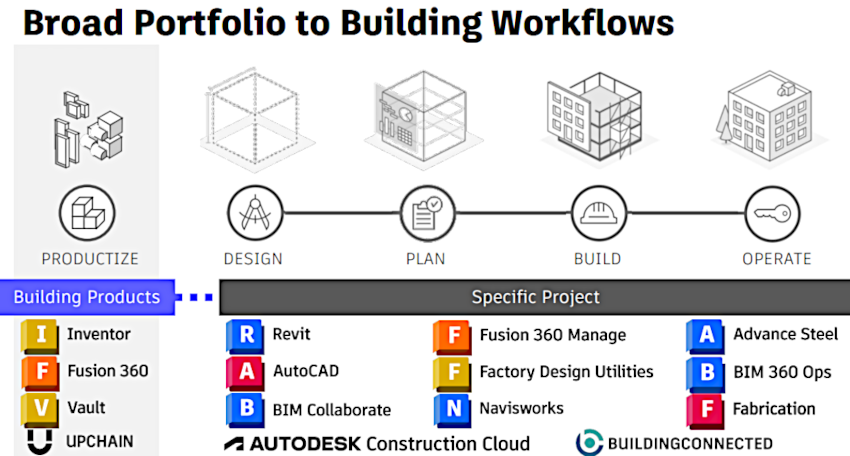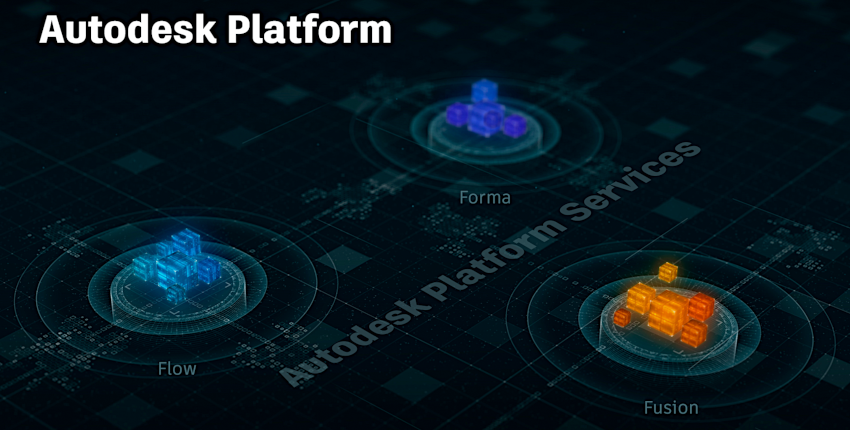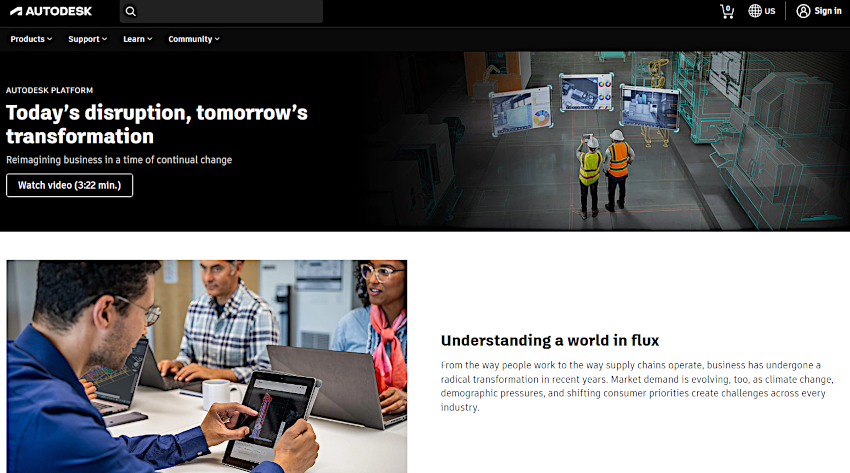
Autodesk’s Grand New Design
By Ralph Grabowski
CAD/CAM/CAECAD giant reveals the company’s latest CAD in the Cloud strategy at annual user conference.

Autodesk CEO Andrew Anagnost introducing Autodesk Fusion, the CAD company’s latest cloud service, to the audience of Autodesk University 2022.
(Photo credit: Autodesk)
Autodesk has, for the most part, seen itself as a software firm for architectural design. That favoritism was evident given the number of sessions at last fall’s Autodesk University 2022: 243 classes were offered on building design and construction; 74 were on manufacturing. In some ways, this is understandable, as the MCAD/CAE/CAM problem has largely been solved. Building construction, by contrast, continues to be hugely under-digitized. Look at any building site: Those aren’t iPads construction workers are carrying around.
Digging into the presentations at AU 2022, we learn that Autodesk is using MCAD’s success to move along building design. Figure 1 shows MCAD as part of the AEC design slate from Autodesk. The number of programs, however, can be overwhelming and even confusing. What, for example, might be the difference between Fusion 360 Manage and BIM 360 Ops? If that’s not enough, Autodesk has 85 other software programs on offer.
Still, not all of MCAD has been a roaring success. Sexy technologies like cloud-based CAD and generative design have found limited adoption; they aren’t the cash cows CAD vendors hoped they would become. Turns out, users prefer practical progress, like better drawing generation from linked 3D models or faster loading of very large assemblies.
Autodesk’s Next Stab at Cloudification
It was a decade ago when then-CEO Carl Bass bluntly stated all Autodesk software would be on servers by 2015: “The only way to use them will be online.” Phil Bernstein, then Autodesk’s vice president of building industry strategy, added, “Right now, we are moving some apps (collaboration and analysis tools) to the cloud. Our long-term strategy is to move everything there.”
It fell to Andrew Anagnost, at the time Autodesk’s senior vice president of industry strategy and marketing, to contradict his boss: “I cannot say why Carl Bass said that. The cloud is really important to us, but it is not the whole story.” He told me back then that the cloud would be an optional way to carry out tasks like analysis and translation.

Figure 1: To bolster digitalization in the AEC market, Autodesk is adding MCAD software throughout its architectural production line.
(Photo credit: Autodesk)
In the end, the Anagnostian view (that cloud should assist desktop CAD) prevailed over the Bass-Bernstein view (that cloud should replace desktop); later, Anagnost prevailed further by becoming CEO after Bass stepped down.
Most CAD vendors today push some form of cloud version of collaborative software, collaboration being an area in which the cloud makes sense. Everyone on a project needs a common meeting point, whether working from home, in the office or on the field. Software running on a remote server can do that quite well, now.
During his Autodesk University 2022 keynote address, made to 19,000 in-person and online attendees in September 2022, CEO Andrew Anagnost offered not just one new cloud service, but three separate ones that he called “industry clouds”.
Autodesk’s Other Fusion
For manufacturing, there is Autodesk Fusion (a name easily confused with Fusion 360, which is for mechanical design). For architecture, engineering, and construction, he announced a separate industry cloud called, Autodesk Forma. The third, Autodesk Flow, is intended for media and entertainment users.
Autodesk’s “Grand New Design” then is three clouds to house all of design and production. The three are, however, promised for some point in the future. Anagnost’s talk was peppered with “will,” “our vision,” and “first offering.” The home Web page for these industry clouds provides little in the way of hard information, sadly.

Formerly known as the Forge programming interface, Autodesk Platform Services will serve as the foundation for the company’s new industrial clouds: Fusion, Flow and Forma.
(Photo credit: Autodesk)
That tentativeness is bit of a letdown, given that we went through a similar emotional ride during the previous AU, which highlighted the Forge programming interface. It too was described by provisional statements like “excited about the potential” and “making strides.” A year later, it remains unfinished, although one of the strides it made was being renamed “Autodesk Platform Services.”
So, what does this new not-360 Fusion do for MCAD users? Autodesk sees it connecting data from many software sources, and between many kinds of users – management, designers and the shop floor. It is not one product, but many held together by the Autodesk Platform Services’ programming interface. Initially, Fusion 360, Fusion 360 Manage, Upchain and Prodsmart will be part of Fusion, with more added later.
As a reminder, Upchain was acquired by Autodesk for its cloud-based PLM (product lifecycle management) and PDM (product data management), and Prodsmart for shop floor scheduling, purchasing and inventory management.
Some of the MCAD functions promised by Anagnost include the following:
• Creating part designs automatically
• Minimizing part and assembly modeling via configurations
• Changing part sizes, loading conditions and tool paths with configurations
• Generating drawings and dimensions automatically
• Flowing all data relevant to a product’s development, from the design firm to the shop floor, including how it was designed, manufactured and how it performed
• Managing machining and fabrication processes
• Handling shop floor scheduling, purchasing inventory management
• Working directly with Fusion 360, Inventor, AutoCAD and Solidworks
• Connecting with plug-ins to non-Autodesk programs, like Rhino
The approach is not new to our industry. Siemens offers its CAD-neutral Web service Xcelerator, which is kind of like Fusion and Autodesk Platform Services combined. Graphics board maker nVidia has its universal, “all are welcome” Omniverse environment.
Disruption
The word Autodesk marketing chose to highlight the three new cloud services is “disruption.” The theme from AU was: Well, you survived the disruption of COVID, you can now survive the disruption of our new software. Anagnost even fit the word several times into one sentence: “Unlike all the unwanted disruption that’s been thrown at us, I believe a disruption of the technology we use to do our jobs, a positive disruption, is probably long overdue.”
There is much customers do not know about Autodesk’s future for them, and so I checked with Autodesk to learn more about the new industry clouds. Four months after the big reveal, it was unable to provide me with more information.
Questions include: How much will these industry clouds cost? Are they glue to connect available software or bundles (i.e. Fusion + Fusion 360 + Upchain + Prodsmart)? Will they work only on Autodesk’s servers or for on-prem installations, as well? What is the future of desktop applications?

Autodesk’s marketing of its industrial clouds uses the word ‘disruption’ as a necessary positive.
(Photo credit: Autodesk)
When Autodesk first promoted the cloud, some believed we would experience unlimited computing power on the cloud.
What we got was a zigzag of products and policies as CAD vendors, including Autodesk, teetered between figuring out how to fund expensive cloud computing providers, such as Amazon, and the limitations inherent in Web browsers communicating with distant servers.
After a decade, the cloud has became very good at certain tasks, like any other technology. Now that realism has set in, customers are better attuned to the parts of cloud from which their operations can benefit.
For now, it’s Autodesk battling itself and its customers. The dream of an all-encompassing system for storing data in a single silo isn’t new. Autodesk faltered through earlier iterations with names like Navisworks, Quantum, and Project Plasma.
Its biggest failure was cloudifying its big three: AutoCAD, Inventor, Revit. AutoCAD Web is a pale imitation; Fusion 360 seems to lack the sales to replace Inventor; and by Anagnost’s own admission, no Web version Revit will ever happen.
Autodesk Fusion’s five-year timeline may provide sufficient runway to adapt to the transition or it might not. The last ten years have shown that a CEO saying “The only way to use [our software] will be online” doesn’t make it so.
www.autodesk.com
Ralph Grabowski writes on the CAD software industry on his blog (www.worldcadaccess.com) and has authored numerous articles and books on CAD.
